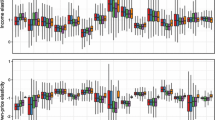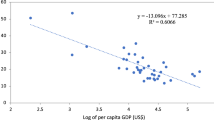Abstract
The COVID pandemic has led to worldwide short-term lockdowns that mostly affected services with personal contact. In economic terms, the lockdown represents a supply shock that simultaneously leads to a demand restriction. The direct effect of the supply constraint is a change in both the structure and the level of consumption. The critical issue for the level effect is the rebound of total consumption, when the lockdown is over. In a model with heterogenous agents that exhibit different consumption structures and different behavior at the aggregate level (‘permanent income hypothesis’ consumers vs. liquidity constrained consumers), the rebound is not complete within the same period, but only over t and t + 1. In the first year, negative aggregate consumption effects are observed. The supply constraints act at the level of single goods and induce large changes in the level of consumption in both directions. This aspect of structural adjustment that occurs without aggregate changes, is an underrepresented issue in the current policy debate. This paper presents a method of consistent implementation of supply constraints via exogenous variables in a nested demand system and of calculating the direct consumption impact across household income groups.




Similar content being viewed by others
References
Alessie R, Michael PD, Guglielmo W (1997) Intertemporal consumption, durables and liquidity constraints: a cohort analysis. Eur Econ Rev 41:37–59
Attanasio OP, Weber G (1995) Is consumption growth consistent with intertemporal optimization? Evidence from the consumer expenditure survey. J Polit Econ 103(6):1121–1157
Auerbach AJ, Gorodnichenko Y (2012) Measuring the output responses to fiscal policy. Am Econ J Econ Pol 4(2):1–27
Baumgartner J, Kaniovski S, Bierbaumer-Polly J, Glocker C, Huemer U, Loretz S, Mahringer H, Pitlik H (2020) Die Wirtschaftsentwicklung in Österreich im Zeichen der COVID-19-Pandemie. Mittelfristige Prognose 2020 bis 2024, WIFO-Monatsberichte 4/2020. WIFO, Wien
Bayer C, Born B, Luetticke R, Müller GJ (2020) The Coronoavirus stimulus package: How large is the transfer multiplier?. CEPR Working Paper, DP 14600, April 2020
Caballero RJ (1993) Durable goods: an explanation of their slow adjustment. J Polit Econ 101:351–384
Caballero RJ (1994) Notes on the theory and evidence on aggregate purchases of durable goods. Oxf Rev Econ Policy 10(2):107–117
Campbell JY, Mankiw GN (1991) The respone of consumption to income: a cross-country investigation. Eur Econ Rev 35:732–767
Carroll CD (1997) Buffer-stock saving and the life cycle/permanent income hypothesis. Q J Econ 112:1–55
Chah EY, Ramey VA, Starr RM (1995) Liquidity constraints and intertemporal consumer optimization: theory and evidence from durable goods. J Money Credit Bank 27:272–287
Deaton A, Muellbauer J (1980) An almost ideal demand system. Am Econ Rev 70(3):312–326
Eberly JC (1994) Adjustment of consumers’ durables stock: evidence from automobile purchases. J Polit Econ 102:403–436
Eggertson GB, Krugman P (2012) Debt deleveraging, and the liquidity trap: a Fisher–Minsky–Koo approach. Q J Econ 127:1–45
Kim K, Kratena K, Hewings GJD (2015) The extended econometric input–output model with heterogenous household demand system. Econ Syst Res 27(2):257–285
Kratena K, Scharner A (2020) MIO-ES: a macroeconomic input–output model with integrated energy system, centre of economic scenario analysis and research (CESAR), Vienna 2020. Available at: https://www.cesarecon.at/wp-content/uploads/2020/10/MIOES_Manual_Public_FINAL.pdf
Landis F, Heindl P (2016) Renewable energy targets in the context of the EU ETS: Whom do they benefit exactly?. ZEW Discussion Paper No. 16-026, March 2016
Luengo-Prado MJ (2006) Durables, non-durables, down payments and consumption excesses. J Monet Econ 53(2006):1509–1539
OeNB (2020) Betroffenheit der österreichischen Unternehmen durch die COVID-19 Pandemie nach Branchen, Konjunktur aktuell, 08/04/2020, Austrian National Bank, Vienna 2020
Ravn MO, Sterk V (2020) Macroeconomic fluctuations with HANK & SAM: an analytical approach. J Eur Econ Assoc 19(2):1162–1202
Sarantis N, Stewart C (2003) Liquidity constraints, precautionary saving and aggregate consumption: an international comparison. Econ Model 20:1151–1173
Schimann S (2020) Subdued Recovery After Strong Rebound Economic Outlook for 2020 and 2021, WIFO Economic Bulletin, 10/2020. WIFO, Wien
Acknowledgements
Funding by the Environment Agency Austria under contract BE-005118 is gratefully acknowledged.
Author information
Authors and Affiliations
Corresponding author
Additional information
Responsible Editor: Fritz Breuss.
Publisher's Note
Springer Nature remains neutral with regard to jurisdictional claims in published maps and institutional affiliations.
Appendix: Aggregation structure and classifications
Appendix: Aggregation structure and classifications
The nested model of consumption deals with energy in a separate way, inserting physical results for energy from bottom-up energy models and converting them into monetary consumption expenditure by implicit pricess. The categories of energy comprise:
The general structure as described in the paper is defined by energy relevant expenditure (categories m) of durable and non-durable spending on the one hand and the non-energy bundle D of non-durables (categories k) on the other hand (Table
4):
Finally, the third nest comprises the level of single goods and services, as shown in Table
5.
Rights and permissions
About this article
Cite this article
Kratena, K. Supply constraints in a heterogenous agents household demand model: a method for assessing the direct impact of the COVID lockdown. Empirica 49, 71–97 (2022). https://doi.org/10.1007/s10663-021-09516-7
Accepted:
Published:
Issue Date:
DOI: https://doi.org/10.1007/s10663-021-09516-7




